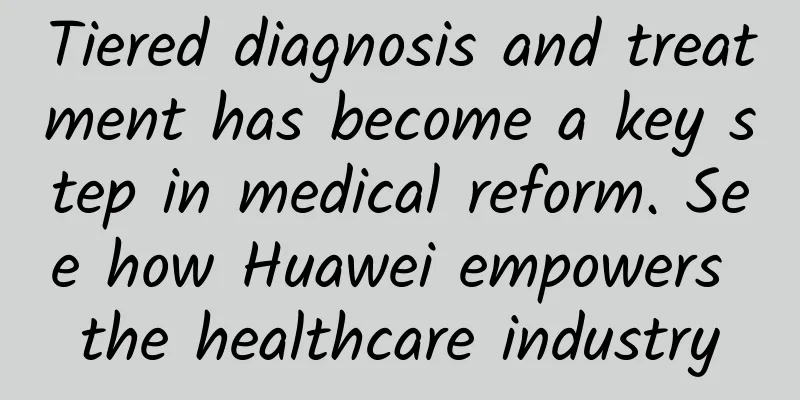Tiered diagnosis and treatment has become a key step in medical reform. See how Huawei empowers the healthcare industry

|
[51CTO.com original article] On April 25, 2018, the 3rd China Healthcare CIO Information Technology Summit and the Summit Forum on Deepening the Construction of Tiered Diagnosis and Treatment with the theme of "Cloud Network New Video Intelligent Health" were successfully held in Guiyang. At the meeting, Li Xuecheng, Director of Huawei EBG China Education and Medical Business Department, Dai Xingjiang, Director of Huawei EBG China Medical Development Department, Lin Yongqi, Director of Huawei Cloud Core Network Product Line Government Industry, and Guan Haitao, Director of Huawei EBG China Education and Medical Ecological Cooperation Department, accepted interviews from the media, talked about the digital transformation of the medical industry, and analyzed the development trends and challenges of the construction of a tiered diagnosis and treatment system. Trend: Interpretation of the national policy on tiered diagnosis and treatment On April 12, 2018, at the State Council Executive Meeting, Premier Li Keqiang explicitly requested that telemedicine be promoted to cover all medical associations and county-level hospitals across the country, that medical resources in the east be connected to the needs of the central and western regions, that high-speed broadband networks be supported to cover urban and rural medical institutions, and that dedicated Internet lines be established to ensure telemedicine needs. At the same time, the State Council Executive Meeting reviewed and approved in principle the "Guiding Opinions on Promoting "Internet + Medical Health"" (hereinafter referred to as the "Opinions"). On April 28, the General Office of the State Council officially issued the "Opinions". The opinions include three aspects: improving the "Internet + Medical Health" service system, improving the "Internet + Medical Health" support system, and strengthening industry supervision and security, and at the same time setting the bottom line for supervision and safety. The Outline of the "Healthy China 2030" Plan proposes to establish a comprehensive, mature and complete hierarchical diagnosis and treatment system, form a reasonable medical treatment order with primary care first diagnosis, two-way referral, linkage between upper and lower levels, and separation of acute and chronic diseases, and build a treatment, rehabilitation, and long-term care service chain. Promoting the establishment and improvement of the hierarchical diagnosis and treatment system aims to solve the problem of unbalanced allocation of medical and health resources and unreasonable flow of patients. In addition, hierarchical diagnosis and treatment ranks first among the five systems in the 13th Five-Year Plan for Deepening the Reform of the Medical and Health System, and proposes to build a reasonable and effective hierarchical diagnosis and treatment system.
Xu Xiangdong, Deputy Director of the Information Technology Department of the Statistical Information Center of the National Health and Family Planning Commission The 3rd China Healthcare CIO Information Technology Summit was held in this context. At the meeting, Xu Xiangdong, deputy director of the Information Technology Department of the National Health and Family Planning Commission's Statistics and Information Center, said that looking back at the policies, my country is steadily completing the construction of a hierarchical diagnosis and treatment system. In 2009, the first policy for deepening medical reform, the "Reform Opinions", proposed the hierarchical diagnosis and treatment system for the first time; in 2011, the general practitioner system was implemented; in 2015, the State Council issued the "Guiding Opinions on Promoting the Construction of a Hierarchical Diagnosis and Treatment System", which also proposed the assessment and evaluation standards for the pilot work of hierarchical diagnosis and treatment; in 2017, the State Council issued the "Guiding Opinions on Promoting the Construction and Development of Medical Alliances", which pointed out that it is necessary to gradually form various forms of medical alliance organizational models based on the actual situation of the construction of the hierarchical diagnosis and treatment system in the region, and to provide classified guidance according to local conditions. Director Xu also pointed out that tiered diagnosis and treatment and the construction of medical alliances are a combination of measures. Tiered diagnosis and treatment mainly solves the problems of primary care, two-way referral, separation of acute and chronic diseases, and coordination between upper and lower levels. When talking about coordination between upper and lower levels, we can talk about medical alliances. Therefore, the main functions of medical alliances can be summed up in three words: "downward (sinking of medical work focus and resources), upward (effectively improving grassroots service capabilities), and connected (connecting between upper and lower levels, two-way referral)". Yang Ping, Vice President of Huawei EBG China As the organizer of the conference, Yang Ping, vice president of Huawei EBG China, said in her speech: "From the establishment of the National Health Commission to the work priorities of various provinces and regions across the country, we can see that health work is shifting from being centered on curing diseases to being centered on people's health, and continuously improving people's health and well-being." Li Xuecheng, Director of Huawei EBG China Education and Healthcare Business Department Li Xuecheng also said in an interview with reporters that the original medical and health informationization refers more to the informationization of medical care and hospitals, with hospitals as the main body and the scope of supervision of the National Health and Family Planning Commission as the standard. Now that "health" has been included, the scope has been further expanded to cover the entire life cycle of residents' health conditions, from prevention to chronic disease management. The proposal of relevant policies on "Internet + medical health" is ultimately aimed at solving people's medical needs from diagnosis and treatment, treatment to chronic disease management and elderly care. Question: Challenges in building a hierarchical diagnosis and treatment system As mentioned above, building a healthy China based on informatization has become a national strategy, especially the construction of tiered diagnosis and treatment has become a key action for the country to implement the new medical reform.
Dai Xingjiang, Director of Huawei EBG China Medical Development Department Dai Xingjiang and the reporter analyzed that the imbalance of medical resources has resulted in people having difficulty seeing a doctor, seeing a doctor at a high cost, and waiting in line for hours to see a doctor for three minutes. This situation is particularly obvious at the grassroots level. Currently, grassroots resources are weak, organizations are not sound, and medical standards are low. The implementation of hierarchical diagnosis and treatment will be based on the severity of the disease and the difficulty of treatment. Different medical institutions will be responsible for the treatment of different diseases, thus solving the above problems. Hierarchical diagnosis and treatment is to promote the sinking of high-quality resources, and the focus is to improve the diagnosis and treatment and service capabilities of primary medical institutions. However, tiered diagnosis and treatment is not just about installing an information system. It is a system built from the aspects of organizational design, institutional design, system guarantee, talent guarantee, and technical support. Among them, information technology is very important. Now, in the process of building tiered diagnosis and treatment systems in various places, information technology faces many challenges. "Compared with the requirements of national health work, the digital transformation of the medical and health industry still faces some problems and challenges. For example: there are still some institutional information islands that have not been completely eliminated, and the interconnection and interoperability between hospitals in the region, hospitals and health administrative management, medical insurance and other institutions at all levels, resource sharing and optimization have not been fully realized. More top-level design work and resource investment are needed in data quality and standards, data collection, interconnection, sharing and coordination mechanisms." Dai Xingjiang said frankly. Methods: Promoting the construction of hierarchical diagnosis and treatment system from the perspective of technology and policy
Lin Yongqi, Director of Government Industry, Huawei Cloud Core Network Product Line So, how can we help the medical and health industry build a hierarchical diagnosis and treatment system? Lin Yongqi answered the reporter from the two aspects of technology and policy: From a technical perspective, the ultimate goal of hierarchical diagnosis and treatment is to resolve the interaction between doctors and patients and realize face-to-face medical consultation. This requires complete ICT infrastructure support and a solid technical support system. In this regard, on the one hand, Huawei provides ICT technical capabilities and communication technology guarantees to achieve information interaction and video signal acquisition. For example, through 4K audio and video capabilities, medical data, images, and CT images can be seen more clearly. On the other hand, Huawei provides platform capabilities, connects with third parties through open ICT platforms, and provides end-to-end solutions with partners to achieve telemedicine. From a policy perspective, the key to whether hospitals and patients recognize telemedicine lies in policy support. In fact, taking the construction of hierarchical diagnosis and treatment in Guizhou Province as an example, Guizhou Province first included telemedicine in the scope of reimbursement of medical insurance and the New Rural Cooperative Medical Scheme, reducing the burden on residents, and at the same time carried out special telemedicine operation and maintenance services in a government-led manner; at the level of work mechanisms, telemedicine management departments have been set up in medical institutions at the provincial, municipal, county, and township levels in Guizhou Province. The telemedicine management department conducts internal scheduling and coordination and contacts externally; at the government level, the provincial government has issued telemedicine management measures, and the Provincial Health Department and the Health and Family Planning Commission have issued implementation rules on the basis of the government management measures, and have made gradual arrangements for the implementation of the details and specific work stipulated in the telemedicine management measures. Ultimately, through Huawei's technology and platform capabilities, with the support of Guizhou Province's policies, tiered diagnosis and treatment in the entire Guizhou province became feasible and easier to use. Practice: Implement the "platform + ecology" strategy and promote the construction of hierarchical diagnosis and treatment Huawei has been committed to promoting the digital transformation of the industry with the "platform + ecosystem" strategy. With its platform with world-leading technology and open architecture as well as clear business boundaries, it has won recognition and support from customers and ecosystem partners. In recent years, under the guidance of the "4631-2 Project", the top-level design plan for the integration of national health and family planning resources, and combined with years of rich experience in the medical industry, Huawei has provided a variety of solutions for the digital transformation of the industry in various fields of medical health. As medical reform continues to deepen and hierarchical diagnosis and treatment continues to advance, Huawei has teamed up with the First Affiliated Hospital of Zhengzhou University, the Health and Family Planning Commission of Guizhou Province, the Health and Family Planning Commission of Jilin Province and other institutions to jointly create a hierarchical diagnosis and treatment system covering different regions. According to Dai Xingjiang, Huawei provides three scenarios solutions for the medical industry: digital hospitals, hierarchical diagnosis and treatment, and universal population health. Through one cloud, one network, and one platform, it helps deepen medical reform and promote hierarchical diagnosis and treatment. Based on advanced technologies such as cloud technology, the Internet of Things, video networks, and big data platforms, it helps medical institutions and patients establish an open, interconnected, shared, and collaborative platform, allowing doctors to better improve themselves in their professional fields, better serve patients, and promote the development of the entire industry to a deeper level. "Huawei is a leading global provider of ICT solutions. Based on its long-term investment in the medical industry, it has successfully delivered many large-scale tiered diagnosis and treatment projects. For example, it has in-depth industry applications and experience in Henan and Guizhou. We have a broad ecosystem, which enables the tiered diagnosis and treatment solutions we provide to better meet the needs of our customers," said Dai Xingjiang. Ecosystem: Aggregate partners to build a medical ecosystem and serve a healthy China It is worth mentioning that, at present, in the medical and health industry, Huawei has established business cooperation relationships with more than 1,000 partners; and has joined hands with dozens of mainstream ISV partners including Donghua Software and Chuangye Software to jointly innovate and successfully released a number of joint solutions for the medical industry. For example, Huawei and three other ISVs, including Weining Health, have joined hands to help Guizhou Province build a unified telemedicine technology architecture of "one network, one platform, and one hub", which has brought together high-quality medical resources from different fields inside and outside the province. From 2016 to March 2018, more than 25,000 remote consultations on difficult and complicated diseases were conducted between institutions, 130,000 remote diagnoses were conducted for township health centers, and more than 300 telemedicine health education and training sessions were held for more than 300,000 people.
Guan Haitao, Director of Education and Healthcare Ecosystem Cooperation Department, Huawei EBG China How does Huawei select partners in the healthcare industry? In this regard, Guan Haitao said that Huawei has formed a relatively mature partner capability certification system in terms of partner selection from the perspective of meeting customer business demand scenarios. "Specifically, we will give priority to high-quality partners in the medical industry to provide joint solutions, and this year we have promoted the new business model of 'Huawei + A to B'. A is Huawei's 'ISV' partner, which provides corresponding joint solutions based on the different levels of customer needs; B is a sales-oriented partner. Huawei will regularly update the shortlist of partners based on multiple dimensions such as A and B's willingness to cooperate, capabilities, and contributions, and through continuous optimization of cooperation, ultimately form a virtuous ecological cycle. Through the joint efforts of Huawei's solution partners, cloud partners, and sales partners, we will ultimately meet the diverse needs of medical customers and achieve a win-win situation for all parties." Guan Haitao revealed. Value: Huawei's three unique values in the healthcare industry In addition, Yang Ping also said in her speech that in the future, Huawei hopes to continue to contribute its unique value in the following three aspects in the healthcare industry: First, Huawei has the most complete ICT infrastructure required for the digital transformation of the healthcare industry, with world-leading technology and based on the collaboration of "ends, pipes, and clouds"; Second, Huawei will actively open up ecological resources for the digital transformation of industries, including the healthcare industry, and work with a wide range of practitioners to create a healthy and prosperous ecosystem for the healthcare industry. Third, Huawei's after-sales service and technical support system, which covers almost all cities and counties across the country, will become a solid guarantee for the digital transformation of the health industry. [51CTO original article, please indicate the original author and source as 51CTO.com when reprinting on partner sites] |
Recommend
Kingsoft Cloud wins "IPv6 Support Excellence Award"; all cloud products have IPv4/IPv6 access capabilities
Recently, the "GNTC 2020 Global Network Tech...
NB-IoT is here! The network is only two months away from being launched, but the chips and platform are ready
With the opening of emerging markets such as wear...
[Heavyweight Tips] 5 steps to build a wireless network!
Here's some heavyweight goodies today! Let’s ...
RAKsmart New Year's Big Offer: E3 servers starting at $30/month, new Korean servers, Hong Kong/Japan/US cluster servers, VPS monthly payment starting at $1.99, GPU servers, high-defense servers
RAKsmart has launched a New Year's Big Sale. ...
The wireless router is placed here, no wonder the WiFi signal is poor
How to solve the problem? Only WiFi! WiFi allows ...
The first batch of 5G mobile phones are about to be launched! What is the use of 5G? Should I change the card or the phone? Finally someone has made it clear...
Hello, everyone. I am Xue Zhiqian of the technolo...
If you don’t know IPv6, you are out of date. What is IPv6?
When using mobile apps, have you noticed that the...
Riverbed Releases SteelFusion 5.0, Adds Support for NAS Storage
[[185144]] Riverbed Technology, the application p...
Internetport: €2/month KVM-512MB/10G SSD/5TB/Sweden VPS
Here is another VPS host in an unpopular area. In...
Two threads, two mutexes, how can a dead loop be formed?
[[351971]] Fans’ questions must be arranged. How ...
Huawei Cloud WeLink is launched to subvert your imagination of smart office
[[311668]] [51CTO.com original article] Huawei Cl...
There are still more than 200 million IPv4 addresses unassigned!
Hello everyone, I’m Xiaofu. In 2019, there were r...
Huawei releases a full range of 5G-A solutions to make 5G-A a reality
[ Dubai , UAE , October 11, 2023 ] During the Glo...
The China-South Korea match at the 40,000-person He Long Sports Center revealed the secrets behind the "Wireless Bee Madness"
On March 23, the Chinese national football team w...
edgeNAT VPS/dedicated servers are 20% off for monthly payment and 30% off for annual payment. Hong Kong VPS bandwidth upgrade price remains unchanged
edgeNAT is a Chinese host provider established in...









